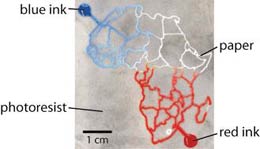
A lab-on-a-chip device can now be made at home on a piece of paper. All it takes is the right paper, ink, and sunlight to create a microfluidic device that can not only test water quality but also identify deceases.
George Whitesides and his colleagues at Harvard developed this new method to help developing countries access the latest lab techniques.
They have found that paper naturally contains pores that can be used to carry liquids just like in standard chips.
In order to make “walls” leak-proof and confine the fluids into narrow channels, the researchers used so called photoresist, a polymer liquid that hardens if subjected to UV radiation.
To make a paper chip, the researchers saturated a piece of regular printer paper with photoresist.
Next, they covered one side of the paper with transparency, and then used a pen to draw the desired pattern of channels on top.
The saturated with photoresist paper hardens under UV light except for the area that was masked beneath the inked-on pattern.
Once the paper dried, the researchers got a leak-proof sheet with a tiny network of embedded permeable channels within. In other words, they got a microfluidic device.
While drawing onto the transparency by hand is not very precise, but Whitesides claimed that the designs could simply be printed onto the transparency using an inkjet printer.
Via NewScientist.com
